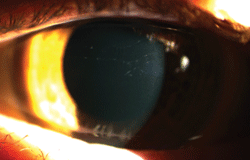 Q: I have a patient with posterior polymorphous corneal dystrophy who is the father of four children—two of whom have inherited the disease. What are the chances that his children will pass the condition on to the next generation? Is there genetic testing available?
Q: I have a patient with posterior polymorphous corneal dystrophy who is the father of four children—two of whom have inherited the disease. What are the chances that his children will pass the condition on to the next generation? Is there genetic testing available?
A: The children who inherited the condition should be counseled that each of their offspring would have a 50% chance of developing posterior polymorphous corneal dystrophy (PPCD). The odds that the two unaffected children in the family would pass the condition on to another generation are slim to none.
“If the patient inherits the mutation, they will exhibit the disease in almost all cases,” says Anthony J. Aldave, MD, director of the Cornea Genetics Laboratory at UCLA’s Jules Stein Eye Institute in Los Angeles. “Could a child of an unaffected individual develop PPCD? It’s possible, but highly unlikely.”
Inherited as an autosomal dominant trait, polymorphous corneal dystrophy affects the corneal endothelium. Clinical characteristics include vesicle-like opacities and parallel bands in Descemet’s membrane.
“In later stages, these bands eventually affect endothelial cell function and cause corneal edema,” says Sherry J. Bass, OD, distinguished teaching professor at SUNY State College of Optometry in New York. “In addition to corneal edema, patients with PPCD are at risk of developing peripheral anterior synechiae, which—if extensive enough—could result in glaucoma. Some pedigrees also have associated keratoconus.” So, it’s important to monitor PPCD patients carefully to make sure you’re on top of any associated conditions that may arise.

This patient exhibited endothelial changes resulting from posterior polymorphous corneal dystrophy. Photo: Jason Jedlicka, OD
Dr. Aldave and colleagues have potentially discovered another clinical feature of the condition. In an article currently under review, they describe a significant percentage of patients with PPCD who have steep corneas (defined as an average keratometry value greater than 48.00D in each eye).
“This is probably not just an isolated endothelial dystrophy. This condition likely also affects the corneal stroma,” says Dr. Aldave, who recently saw a PPCD patient post-LASIK who had developed ectasia after the surgery. “Optometrists who refer patients to refractive surgeons should be aware that these patients often have steep corneas, and there should be a very careful examination prior to LASIK surgery before considering them as candidates.”
Mutations associated with PPCD have been reported in a number of genes, including VSX1, COL8A2 and ZEB1 (although convincing evidence exists only for ZEB1). “Currently, there are no commercial genetic testing laboratories that offer tests for PPCD, although they do offer testing for another gene (TGFB1) that causes some of the stromal corneal dystrophies,” Dr. Bass says. “Perhaps genetic testing for PPCD will be offered in the future.”
At this point, identifying a mutation in an affected individual is mainly for research purposes because it doesn’t change the clinical management of the condition.
Most patients with PPCD don’t require treatment, but in Dr. Aldave’s collection of 46 affected families, more than 20% of patients have required corneal transplantation. Deciding whether penetrating or endothelial keratoplasty is the most appropriate procedure depends, in part, on whether significant corneal steepening is present in addition to endothelial decompensation, Dr. Aldave says.

